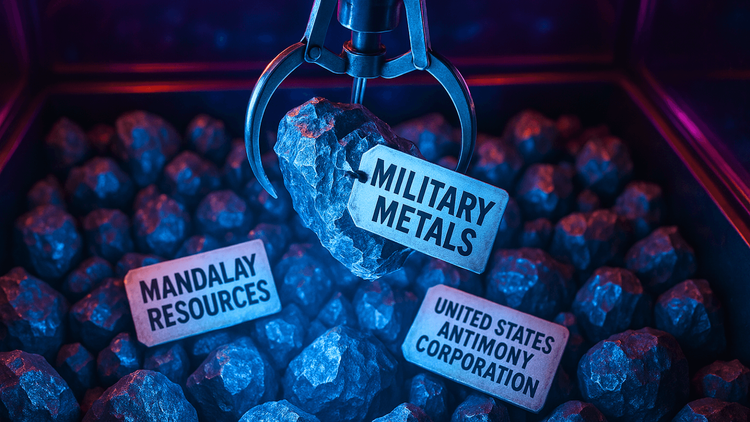The Rise of China as a Critical Mineral Superpower
China’s Ascendancy in Critical Minerals: A Game-Changer for Global Geopolitics and Manufacturing

China’s influence over critical minerals is rapidly solidifying, reshaping not just its economy but the entire global landscape. With the world's increasing reliance on advanced technologies and renewable energy, China stands at the helm of a mineral revolution. Its dominance in the production of essential elements like lithium, graphite, and refined copper has broad implications for global manufacturing, international investment, and geopolitical dynamics. Let’s unpack this intricate web of control and influence.
China's Critical Mineral Footprint
According to data from the International Energy Agency (IEA), China accounts for approximately 80% of natural graphite and around 60% of mined magnet rare earths. This staggering dominance extends beyond mere extraction; it includes significant refining and processing capabilities that set China apart in the global market.
Amrita Dasgupta, an energy and mineral supply chain analyst at the IEA, emphasizes that China is not just a player but the leading producer of refined copper, lithium, cobalt, graphite, and magnet rare earths. Today, the country produces an astounding 99% of battery-grade graphite and over 60% of lithium chemicals. This control shapes everything from energy storage solutions to electric vehicle (EV) production, underscoring the strategic importance of these minerals in a rapidly evolving economy.
The trajectory of China’s control has evolved over the past decade, according to Jon Harrison, managing director of emerging markets macro strategy at TS Lombard. He notes that, in recent years, “China has gradually tightened its control” over critical minerals through enhanced processing, licensing, and regulation. This strategy has led to curtailed access for foreign companies and increased domestic dominance.
China’s grasp over the copper, lithium, and nickel markets exemplifies its strategic maneuvers. Shobhan Dhir, an IEA critical mineral analyst, points out that China is expected to maintain its supremacy in the refined copper market well into 2040, potentially surpassing Peru in terms of global mined copper supply.
The same trend holds true for lithium. IEA analyst Eric Buisson notes that China’s share of lithium mining has surged from 6% in 2016 to 17% in 2023, with projections indicating that China will soon overtake Chile as the world’s second-largest lithium producer. This shift is not just about numbers; it represents a broader strategy to control the resources that fuel future technologies.
Investment Trends: Domestic and International
China’s investment in critical minerals reflects its broader economic strategy, particularly through the Belt and Road Initiative (BRI). This ambitious program has catalyzed a dramatic increase in Chinese investments in the mining sector, reaching a decade-high of $19.4 billion in 2023—an impressive 160% increase from 2022.
This investment surge is not limited to domestic projects; it extends internationally, particularly in Africa, where Chinese firms have significantly invested to create new lithium supply chains. Notably, five of the seven lithium assets expected to start production in Africa by 2027 will have at least 50% equity ownership by Chinese companies. This proactive approach ensures that China maintains a foothold in crucial markets and minimizes the risk of supply disruptions.
The driving force behind China’s investment in critical minerals is its ambition to dominate clean energy technology manufacturing. Currently, China produces two-thirds of the world’s electric vehicles and boasts a staggering 85% of battery cell production. Its focus on renewable energy sources, including solar and wind, complements its strategic investments in essential materials.
Francesca Gregory, a senior energy transition analyst at GlobalData, points out that China’s efforts to become a green technology pioneer are integral to its economic growth. The country plans to allocate a jaw-dropping $6 trillion to green investment in its 14th Five-Year Plan, cementing its status as a critical mineral monolith.
The Geopolitical Implications of China’s Dominance
As China consolidates its grip on critical minerals, concerns regarding single-source dependence grow. Gregory highlights that lithium, essential for energy storage and EV markets, could become a chokepoint in global supply chains. Geopolitical tensions further exacerbate these worries, making the reliance on a single nation for crucial resources increasingly perilous.
The concentration of polysilicon production—another key material for solar panels—also raises alarms. China commands an 80% share in various stages of solar panel manufacturing, from raw material processing to final product fabrication. This consolidation of power poses risks of energy dependence that could stifle innovation and lead to price volatility in the global market.
China’s dominance in critical mineral processing has profound implications for the global mining industry. According to Tom Moerenhout, a research scholar at Columbia University’s Centre on Global Energy Policy, China's price advantage allows it to push down costs, making it challenging for other nations to compete effectively.
Western mining companies are increasingly reassessing their strategies in response to these challenges. Stewart Worthy, a partner at Dorsey & Whitney, mentions that many are exploring innovative solutions, such as a two-tier pricing system that offers a premium for sustainably produced metals. However, whether this approach will gain traction remains uncertain.
Navigating the US-China Trade War
China's rising influence in critical minerals has significant ramifications for ongoing tensions between the US and China. As the US seeks to decouple its economy from China, it faces the challenge of addressing its dependence on critical minerals essential for modern technology.
Harrison notes that, since 2017, China has tightened its control over rare earths and critical minerals, using its market power as a geopolitical tool. In response, the US has implemented measures to limit China’s access to advanced technologies, signaling a broader strategy to reduce reliance on Chinese supply chains.
The dynamics of the US-China trade war have intensified the competitive landscape. Moerenhout points out that China's export restrictions have expanded beyond semiconductors to encompass critical minerals. This move is seen as a strategy to diminish competition and maintain control over vital resources.
As these trade tensions escalate, Western nations must devise strategies to mitigate risks associated with supply chain vulnerabilities. The push for greater independence in critical mineral sourcing has become a focal point in discussions on national security and economic resilience.
Conclusion
China's role as a critical mineral monolith is reshaping the global landscape in profound ways. As the country consolidates its dominance over essential minerals, it raises questions about the sustainability of supply chains, the competitiveness of other nations, and the geopolitical ramifications of such power. As reliance on these resources grows, so does the urgency for Western nations to diversify their supply sources and reassess their strategies to secure a competitive edge.
In the evolving world of critical minerals, understanding China’s role is paramount for any stakeholder in the mining, technology, or energy sectors. The landscape is fraught with challenges and opportunities, and navigating it will require keen insights and strategic foresight.






